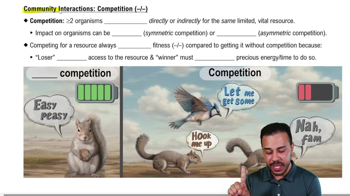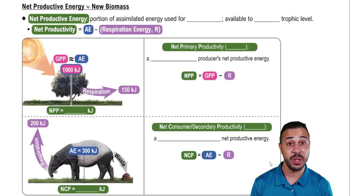Table of contents
- 1. Introduction to Biology2h 42m
- 2. Chemistry3h 40m
- 3. Water1h 26m
- 4. Biomolecules2h 23m
- 5. Cell Components2h 26m
- 6. The Membrane2h 31m
- 7. Energy and Metabolism2h 0m
- 8. Respiration2h 40m
- 9. Photosynthesis2h 49m
- 10. Cell Signaling59m
- 11. Cell Division2h 47m
- 12. Meiosis2h 0m
- 13. Mendelian Genetics4h 44m
- Introduction to Mendel's Experiments7m
- Genotype vs. Phenotype17m
- Punnett Squares13m
- Mendel's Experiments26m
- Mendel's Laws18m
- Monohybrid Crosses19m
- Test Crosses14m
- Dihybrid Crosses20m
- Punnett Square Probability26m
- Incomplete Dominance vs. Codominance20m
- Epistasis7m
- Non-Mendelian Genetics12m
- Pedigrees6m
- Autosomal Inheritance21m
- Sex-Linked Inheritance43m
- X-Inactivation9m
- 14. DNA Synthesis2h 27m
- 15. Gene Expression3h 20m
- 16. Regulation of Expression3h 31m
- Introduction to Regulation of Gene Expression13m
- Prokaryotic Gene Regulation via Operons27m
- The Lac Operon21m
- Glucose's Impact on Lac Operon25m
- The Trp Operon20m
- Review of the Lac Operon & Trp Operon11m
- Introduction to Eukaryotic Gene Regulation9m
- Eukaryotic Chromatin Modifications16m
- Eukaryotic Transcriptional Control22m
- Eukaryotic Post-Transcriptional Regulation28m
- Eukaryotic Post-Translational Regulation13m
- 17. Viruses37m
- 18. Biotechnology2h 58m
- 19. Genomics17m
- 20. Development1h 5m
- 21. Evolution3h 1m
- 22. Evolution of Populations3h 53m
- 23. Speciation1h 37m
- 24. History of Life on Earth2h 6m
- 25. Phylogeny2h 31m
- 26. Prokaryotes4h 59m
- 27. Protists1h 12m
- 28. Plants1h 22m
- 29. Fungi36m
- 30. Overview of Animals34m
- 31. Invertebrates1h 2m
- 32. Vertebrates50m
- 33. Plant Anatomy1h 3m
- 34. Vascular Plant Transport1h 2m
- 35. Soil37m
- 36. Plant Reproduction47m
- 37. Plant Sensation and Response1h 9m
- 38. Animal Form and Function1h 19m
- 39. Digestive System1h 10m
- 40. Circulatory System1h 49m
- 41. Immune System1h 12m
- 42. Osmoregulation and Excretion50m
- 43. Endocrine System1h 4m
- 44. Animal Reproduction1h 2m
- 45. Nervous System1h 55m
- 46. Sensory Systems46m
- 47. Muscle Systems23m
- 48. Ecology3h 11m
- Introduction to Ecology20m
- Biogeography14m
- Earth's Climate Patterns50m
- Introduction to Terrestrial Biomes10m
- Terrestrial Biomes: Near Equator13m
- Terrestrial Biomes: Temperate Regions10m
- Terrestrial Biomes: Northern Regions15m
- Introduction to Aquatic Biomes27m
- Freshwater Aquatic Biomes14m
- Marine Aquatic Biomes13m
- 49. Animal Behavior28m
- 50. Population Ecology3h 41m
- Introduction to Population Ecology28m
- Population Sampling Methods23m
- Life History12m
- Population Demography17m
- Factors Limiting Population Growth14m
- Introduction to Population Growth Models22m
- Linear Population Growth6m
- Exponential Population Growth29m
- Logistic Population Growth32m
- r/K Selection10m
- The Human Population22m
- 51. Community Ecology2h 46m
- Introduction to Community Ecology2m
- Introduction to Community Interactions9m
- Community Interactions: Competition (-/-)38m
- Community Interactions: Exploitation (+/-)23m
- Community Interactions: Mutualism (+/+) & Commensalism (+/0)9m
- Community Structure35m
- Community Dynamics26m
- Geographic Impact on Communities21m
- 52. Ecosystems2h 36m
- 53. Conservation Biology24m
44. Animal Reproduction
Animal Reproduction
Problem 2
Textbook Question
In sperm competition, what is 'second-male advantage'?
a. The observation that when females mate with two males, each male fertilizes the same number of eggs
b. The observation that when females mate with two males, the second male fertilizes most of the eggs
c. The observation that females routinely mate with at least two males before laying eggs or becoming pregnant
d. The observation that accessory fluids prevent matings by second males—for example, by forming copulatory plugs
 Verified step by step guidance
Verified step by step guidance1
Understand the concept of sperm competition: Sperm competition occurs when the sperm of two or more males compete to fertilize the eggs of a female. This is common in species where females mate with multiple males.
Identify the term 'second-male advantage': This refers to a phenomenon observed in sperm competition where the second male to mate with a female has a higher chance of fertilizing the majority of the eggs.
Analyze the options given: We need to find the option that best describes the 'second-male advantage'.
Evaluate option b: 'the observation that when females mate with two males, the second male fertilizes most of the eggs'. This directly describes the second-male advantage, where the second male's sperm is more successful in fertilizing eggs.
Conclude that option b is the correct description of the 'second-male advantage', as it aligns with the definition of the term in the context of sperm competition.
 Verified video answer for a similar problem:
Verified video answer for a similar problem:This video solution was recommended by our tutors as helpful for the problem above
Video duration:
1mPlay a video:
Was this helpful?
Key Concepts
Here are the essential concepts you must grasp in order to answer the question correctly.
Sperm Competition
Sperm competition refers to the biological phenomenon where the sperm of different males compete to fertilize the eggs of a female. This occurs when a female mates with multiple males, leading to a competitive environment for the sperm to achieve fertilization. It is a significant factor in sexual selection and can influence male reproductive strategies.
Recommended video:
Guided course

Community Interactions: Competition (-/-)
Second-Male Advantage
Second-male advantage is the observation that when a female mates with two males, the sperm of the second male often has a higher chance of fertilizing the eggs compared to the first male. This advantage can arise due to various factors, such as the timing of mating, sperm displacement, or physiological mechanisms that favor the second male's sperm.
Recommended video:
Guided course

Second Law of Thermodynamics
Copulatory Plugs
Copulatory plugs are gelatinous secretions produced by males during mating that can block the female's reproductive tract, preventing subsequent matings by other males. This mechanism is a form of post-copulatory sexual selection, aimed at ensuring the first male's sperm has a better chance of fertilizing the eggs by physically obstructing other males' sperm.
Recommended video:
Guided course

Net Productive Energy ≈ New Biomass

 5:44m
5:44mWatch next
Master Sexual and Asexual Reproduction with a bite sized video explanation from Jason
Start learningRelated Videos
Related Practice
Textbook Question
This graph plots the rise and fall of pituitary and ovarian hormones during the human ovarian cycle. Identify each hormone (A–D) and the reproductive events with which each one is associated (P–S). For A–D, choose from estrogen, LH, FSH, and progesterone. For P–S, choose from ovulation, growth of follicle, menstruation, and development of corpus luteum. How would the right-hand side of this graph be altered if pregnancy occurred? What other hormone is responsible for triggering this change?
2879
views
